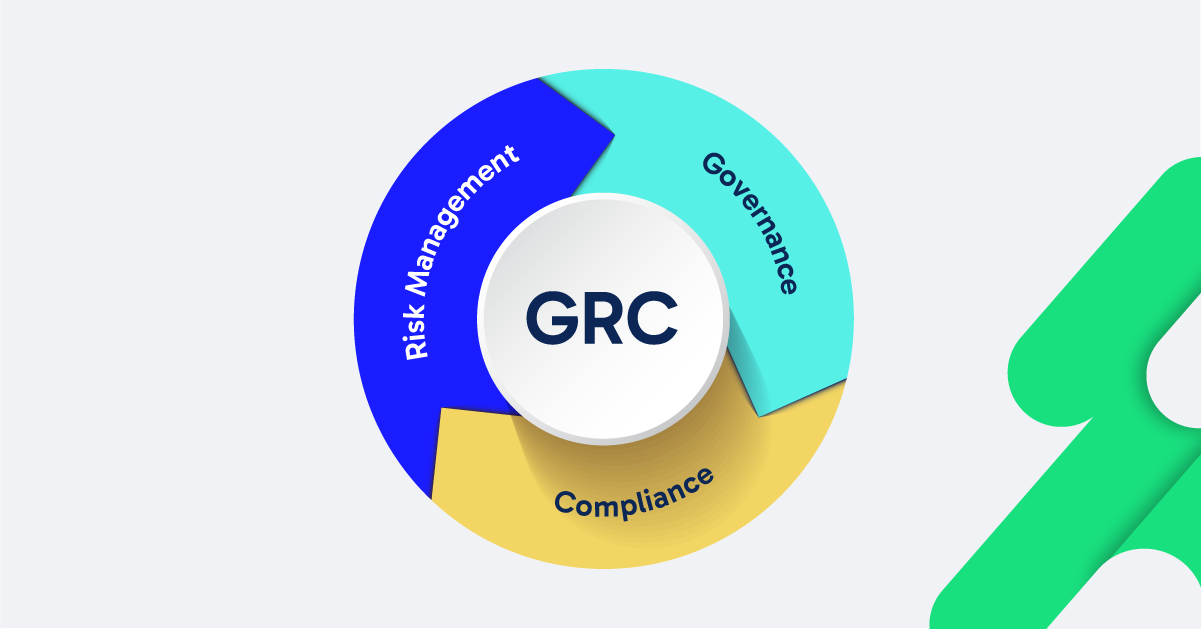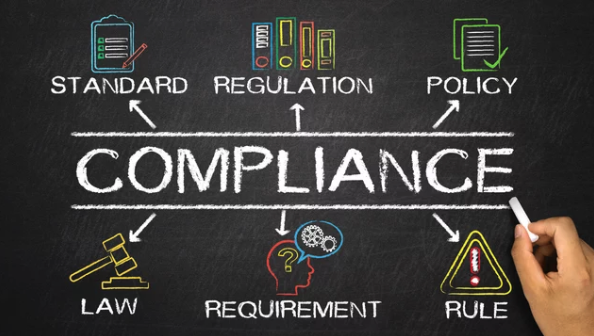- Blog
- 04.08.2024
- Technically Speaking
Getting Started with Governance, Risk and Compliance

Concept of Governance, Risk, and Compliance
Governance, Risk, and Compliance (GRC) denotes the collection and execution of critical capabilities required to manage Governance, risk, and compliance matters in the organization more effectively. GRC operates as an independent body in the organization and is solely responsible for managing the organization's risks and compliance requirements. GRC is a structured way to align IT with business goals while managing risks and meeting all industry and government regulations. It includes tools and processes to unify an organization’s governance and risk management with its technological innovation and adoption.
What does Governance, Risk, and Compliance stand for?
GRC stands for governance, risk (management), and compliance. Most businesses are familiar with these terms but have practiced them separately in the past. GRC combines governance, risk management, and compliance in one coordinated model. This helps your company reduce wastage, increase efficiency, reduce noncompliance risk, and share information more effectively.
Defining Governance
Governance is the set of policies, rules, or frameworks that a company uses to achieve its business goals. It defines the responsibilities of key stakeholders, such as the board of directors and senior management. For example, good corporate governance supports your team in including the company’s social responsibility policy in their plans. Governance refers to the ethical management of an organization by its leaders in accordance with approved business plans and strategies. Good governance includes the following:
- Ethics, Conduct, and Accountability.
- Policy Management
- Employee health and safety
- Conflict resolution policies
- Resource management

Defining Risk Management
All businesses face different types of risks, including financial, legal, strategic, and security risks. Proper risk management helps businesses identify these risks and find ways to remediate any that are found. Companies use an enterprise risk management program to predict potential problems and minimize losses. For example, you can use risk assessment to find security loopholes or findings in your computer system and apply a fix. Risk management refers to an organization’s process for identifying, categorizing, assessing and enacting strategies to minimize risks that would hinder its operations and to control risks that are arising in day-to-day business.

Defining Compliance
Compliance is the act of following rules, laws, and regulations. It applies to legal and regulatory requirements set by industrial bodies and to internal corporate policies. In GRC, compliance involves implementing procedures to ensure that business activities comply with the respective regulations. For example, organizations storing and processing EU citizens' or customers' data must comply with laws like GDPR that protect individual or customers' privacy. Compliance refers to the level of adherence an organization must adhere to the standards, regulations, and best practices mandated by the business and by relevant governing bodies and laws.

Why is Governance, Risk, and Compliance so important?
By implementing appropriate GRC Framework and GRC programs, businesses can make better decisions in a risk-aware environment. An effective GRC program helps key stakeholders set policies from a shared perspective and comply with regulatory requirements. With GRC, the entire company comes together in its policies, decisions, and actions. As businesses grow increasingly complex, they need a way to identify and manage key activities in the organization effectively. Also the ability to integrate traditional distinct management activities into a cohesive discipline that increases the effectiveness of people, business processes, technology, facilities, and other important business elements. GRC achieves this by breaking down the traditional barriers between business units and requiring them to work in a collaborative fashion to achieve the company’s strategic goals.
The GRC team helps the organization set the right tone and leads it to meet the governance, risk, and compliance objectives set by its board members. It also sets the organization on the path to achieving a good security posture to solidify the strength of overall risk and security.
Benefits of effective GRC operations:
- Improved and better decision-making - One can make decisions within a shorter time frame by monitoring your resources, setting up rules or frameworks, and using GRC software and Tools.
- Clear visibility on Responsibility and Accountability - GRC streamlines operations around a common culture that promotes ethical values and creates a healthy environment for growth. It guides the development of a strong organizational culture and ethical decision-making in the organization. GRC sets the tone at the top of who is responsible for doing what, segmenting the roles, defining the objectives, aligning with standards, etc.
- Improved cybersecurity awareness - With a formulated integrated GRC approach, Organizations can employ data security measures to protect customer data and personal information. Implementing a GRC strategy is essential for all organizations due to increasing cyber risk that threatens users’ data and privacy. It helps organizations comply with data privacy regulations like the General Data Protection Regulation (GDPR). With a GRC IT security strategy, you build customers', partners', and stakeholders' trust and protect your business from penalties.
The Importance of Governance, Risk, and Compliance Implementation
Companies of all sizes face challenges that can endanger revenue, reputation, and customer and stakeholder interest. Some of these challenges include the following:
- Connection to the internet world introduces cyber risks that might compromise data storage security.
- Businesses always want to comply with new or updated regulatory requirements.
- Data privacy and protection for customers and partners
- Risk management costs increasing at an unprecedented rate.
- Supply chain Risks are arising due to business growth.
These challenges create demand for a strategy to navigate businesses toward their goals. Conventional third-party risk management and regulatory compliance methods are not enough. Hence, GRC was introduced as a performance principled approach to help stakeholders make accurate decisions.
Why Governance, Risk, and Compliance is required by every organization?
The GRC team helps the organization set the right tone and leads it to meet the governance, risk, and compliance objectives set by its board members. It also sets the organization on the path to achieving a good security posture to solidify and strengthen the overall governance, risk, and compliance programs.
Who Manages the Governance, Risk, and Compliance department?
GRC acts as an independent body in the organization from any other business functions. It must be overseen independently by the organization's Board of Members or led or supervised by executive roles like CISO (Chief Information Security Officer), CRO (Chief Risk Officer), or Head of security.
How does GRC work?
GRC in any organization works on the following principles:
- Key stakeholders - GRC requires cross-functional collaboration across different departments that practice governance, risk management, and regulatory compliance. Some examples include the following:
- Senior executives who assess risks when making strategic decisions
- Legal teams help businesses mitigate legal exposures.
- Finance managers who support compliance with regulatory requirements
- HR executives who deal with confidential recruitment information
- IT departments that protect data from cyber threats
- GRC framework - A GRC framework is a model for managing governance and compliance risk in a company. It involves identifying the key policies that can drive the company toward its goals. By adopting a GRC framework, you can take a proactive approach to mitigating risks, making well-informed decisions, and ensuring business continuity. Companies implement GRC by adopting GRC frameworks that contain key policies that align with the organization’s strategic objectives. Key stakeholders base their work on a shared understanding of the GRC framework as they devise policies, structure workflows, and govern the company. Companies might use software and tools to coordinate and monitor the success of the GRC framework.
- GRC maturity - GRC maturity is the level of integration of governance, risk assessment, and compliance within an organization. You achieve a high level of GRC maturity when a well-planned GRC strategy results in cost efficiency, productivity, and effectiveness in risk mitigation. Meanwhile, a low level of GRC maturity is unproductive and keeps business units working in silos.
What is the GRC Capability Model? - The GRC Capability Model contains guidelines that help companies implement GRC and achieve principled performance. It ensures a common understanding of communication, policies, and training. You can take a cohesive and structured approach to incorporate GRC operations across your organization.
- Learn: You learn about your company's context, values, and culture so you can define strategies and actions that reliably achieve objectives.
- Align: Ensure that your strategy, actions, and objectives are in alignment. When making decisions, consider opportunities, threats, values, and requirements.
- Perform: GRC encourages you to take actions that bring results, avoid those that hinder goals, and monitor your operations to detect sudden changes.
- Review: You revisit your strategy and actions to ensure they align with the business goals. For example, regulatory changes could require a change of approach.
How do organizations implement an effective GRC strategy?
To implement GRC, the organization should integrate different parts of the business into a unified framework. Building an effective GRC requires continuous evaluation and improvement. The following tips make GRC implementation easier.
- Define clear goals and objectives - Start by determining what goals you want to accomplish with the GRC model. For example, you might want to address the risk of non-compliance to data privacy laws, enforce required policies, conduct various gap analysis, etc
- Assess existing policies and procedures - Evaluate your company's current policies, processes, and technologies for governance, risk, and compliance. Then, plan and choose the right GRC frameworks and tools.
- Start with the Right foot - Executive-level management or board members, who are at the top of the organization's hierarchy, play a vital and leading role in implementing GRC programs. They must understand the benefits of implementing GRC programs and how they help them make decisions and build a risk-aware culture. Top leaders or Board Members must set the right tone from the beginning to implement GRC-related programs and spread a risk awareness culture. Other concerned departments must also support them to enable risk culture in the entire organization.
- Test the GRC framework - Test the GRC framework on one business unit or process and evaluate whether the chosen framework aligns with your goals. By conducting small-scale testing, you can make helpful changes to the GRC system before implementing it in the entire organization.
- Setting clear roles and responsibilities - GRC is a collective team effort. Although senior executives are responsible for setting key policies, legal, finance, and IT personnel are equally accountable for GRC's success. Defining the roles and responsibilities of each employee promotes accountability. It allows employees to report and address GRC issues promptly.
- Data management - Companies have long been operating by keeping departmental functions separated. Each department generates and stores its own data. GRC works by combining all the data within an organization. This results in duplicate data and introduces challenges in managing information.
- Lack of a total GRC framework - A complete GRC framework integrates business activities with GRC components. It serves the changing business environment, particularly when you are dealing with new regulations. Without a seamless integration, your GRC implementation is likely to be fragmented and ineffective.
- Culture development - Getting every employee to share an ethically compliant culture takes great effort. Senior executives must set the tone of transformation and ensure that information is passed through all layers of the organization.
- Transparency in communication - The success of GRC implementation depends on seamless communication. Information sharing must be transparent between GRC compliance teams, stakeholders, and employees. This makes activities like creating policies, planning, and decision-making easier.
- GRC software - GRC software combines applications that manage the core functions of GRC into a single integrated package. It enables an organization to pursue a systematic, organized approach to managing GRC-related strategy and implementation. Instead of using siloed applications, administrators can use a single framework to monitor and enforce rules and procedures. Successful installations enable organizations to manage risk, reduce costs incurred by multiple installations, and minimize complexity for managers. Effective GRC software includes risk examination and risk assessment tools that identify linkages to business processes, internal controls, and operations. GRC software helps automate GRC frameworks and integrate various programs in one place. Businesses use GRC software to perform tasks like below:
- Manage policies and risk and ensure compliance programs.
- Stay updated about various regulatory changes that affect the business.
- Manage multiple business units to work together on a single platform.
- Manage Audits in one place.
Some of the following GRC tools to integrate business processes, reduce costs, and improve efficiency.
Identity & User Access Management - With user management software, various stakeholders can be given the right to access company resources. This software supports granular authorization, so you can precisely control who has access to what information. User access management ensures that everyone can securely access the resources they need to get their work done. Some of the tools employ great features such as Zluri, Okta, CyberArk, etc.
Auditing - Many auditing tools, such as OneTrust, ZenGRC, Audit Board, RFT Compliance Manager, etc., can be used to evaluate and track the results of integrated GRC activities in the company. By running internal audits, you can compare actual performance with GRC goals and track it effectively by using proper GRC solutions and investing in them.
Training and Awareness - Many tools are available, such as Knowb4(KCM), Bullphish ID, Rapidfire tools, Phished, etc., to conduct successful campaigns in the organization. Organizations must invest in the right tools to make GRC a successful program.
Risk & Compliance
- Enable data-driven decision-making: Align leadership on the risks affecting your entire organization. Effectively showcase strategic risks across the organization so you can take immediate action.
- Customize your ERM(Enterprise Risk Management) program: Tailor the use of ERM software based on your organization’s unique risk appetite. Easily configure industry-specific best practices, regulatory standards and more.
- Maximize efficiencies: ERM systems efficiently demonstrate organizational risk impact to your leaders. Access and customize risk data into real-time insights and one-click reports for stakeholders' crucial analysis.
- Compliance Manager:Drive compliance programs to identify the gaps in the process and easily identify and map the controls based on various standards like GDPR, SOC2, NIST, HIPAA and ISO 27001 and measure the compliance rates by adhering to these standards.
- Some of the integrated solutions like Archer Insight, AuditBoard, Diligent, Drata and other platforms which gives the ability to fast track the risk and compliance management activities and produces the metrics which can be presentable quickly to leadership management.
Conclusion
Many organizations of different sizes and based on the nature of business, demand them to combine or integrate GRC into the Cyber Security to represent and work as a single operating department within the organization due to scalability issues, which is ideally not recommendable and not a sustainable strategy in the long run and where business has grown tremendously over the period of years and further anticipating huge growth in the business. Both teams must be functionally separated and overseen by keeping the objectives or targets separate but must work together in order to contribute to the development and fostering of cyberculture. It is pivotal to consider and evaluate the situation based on company size, team capacity, funding, depth of business to consider, products involved, segregation of roles and responsibilities from team to team and reviewing the whole team's structure continuously from time to time is crucial for it to be considered as successfully established or matured business in nature and also in order to meet different industry standards.

Darshan Krishnappa
Technical Program Manager, GRC
CGRCP & ISO 27001 LA
Featured Resources
What Are Feature Flags?
Feature flags are a software development tool that has the capability to control the visibility of any particular feature. ...
BlogHow Your Data Teams Can Do More With Marketing Analytics
Improve your marketing analytics with Matillion Data Productivity Cloud that enables businesses to centralize and integrate ...
BlogThe Importance of Data Classification in Cloud Security
Data classification enables the targeted protection and management of sensitive information. Personally Identifiable ...
Share: